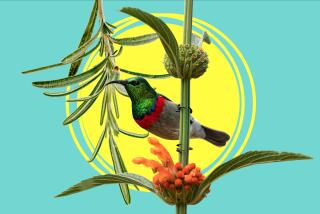Bread Banana
- Share via
What tropical root vegetable grows as an ornamental plant beside many California swimming pools? Ensete ventricosum, a member of the banana family otherwise known as false banana.
With its huge leaves (which can grow up to 20 feet long by 5 feet wide), it has a lush tropical look, particularly the reddish-leaved variety. The only problem with it is that it dies back after a couple of years, which is why pool owners often grow it in pots.
But in Ethiopia, die-back is when the plant really becomes welcome. The root is dug up, scraped, pounded, moistened and buried in a pit to ferment for anything from a couple of weeks to a couple of months. Then it’s disinterred and made into porridge or bread.
Even after fermentation, though, ensete is a rather rugged, fibrous food. Ensete bread (known as wesa in many Ethiopian languages) is quite tough and considered inedible by itself. If you have butter or cheese, or stewed meat, you eat that along with your wesa. If you don’t, you at least want some stewed cabbage with it.
This sounds like a lot of trouble for not much reward, but root vegetables are important in the tropics, where most grains don’t do well, and ensete (which was also eaten by the ancient Egyptians) is the staff of life in lowland Ethiopia. Among the Chaha people, for instance, breakfast is toasted wesa with cheese, meat or cabbage, and lunch is wesa with cheese, cabbage or zemamojat (a mixture of cheese, butter, cabbage and spices).
Even ensete porridge is often doused with butter, but that might just be because in Ethiopia, it’s believed that butter is what gives all food flavor.


